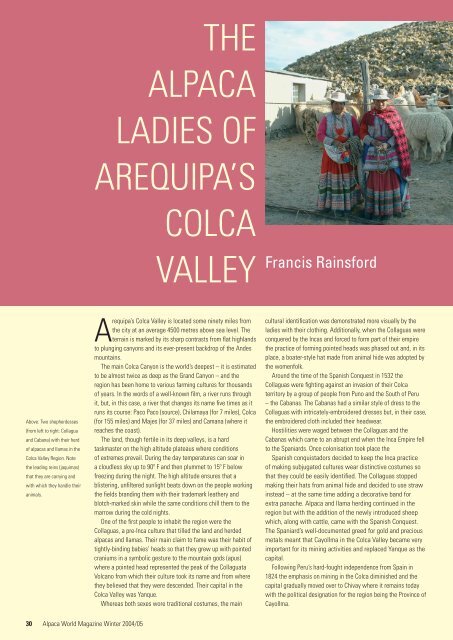Create successful ePaper yourself
Turn your PDF publications into a flip-book with our unique Google optimized e-Paper software.
Above: Two shepherdesses<br />
(from left to right: Collagua<br />
and Cabana) with their herd<br />
of alpacas and llamas in the<br />
Colca Valley Region. Note<br />
the leading reins (jaquimas)<br />
that they are carrying and<br />
with which they handle their<br />
animals.<br />
30 Alpaca World Magazine <strong>Winter</strong> 2004/05<br />
THE<br />
ALPACA<br />
LADIES OF<br />
AREQUIPA’S<br />
COLCA<br />
VALLEY<br />
Arequipa’s Colca Valley is located some ninety miles from<br />
the city at an average 4500 metres above sea level. The<br />
terrain is marked by its sharp contrasts from fl at highlands<br />
to plunging canyons and its ever-present backdrop of the Andes<br />
mountains.<br />
The main Colca Canyon is the world’s deepest – it is estimated<br />
to be almost twice as deep as the Grand Canyon – and the<br />
region has been home to various farming cultures for thousands<br />
of years. In the words of a well-known fi lm, a river runs through<br />
it, but, in this case, a river that changes its name fi ve times as it<br />
runs its course: Paco Paco (source), Chilamaya (for 7 miles), Colca<br />
(for 155 miles) and Majes (for 37 miles) and Camana (where it<br />
reaches the coast).<br />
The land, though fertile in its deep valleys, is a hard<br />
taskmaster on the high altitude plateaus where conditions<br />
of extremes prevail. During the day temperatures can soar in<br />
a cloudless sky up to 90º F and then plummet to 15º F below<br />
freezing during the night. The high altitude ensures that a<br />
blistering, unfi ltered sunlight beats down on the people working<br />
the fi elds branding them with their trademark leathery and<br />
blotch-marked skin while the same conditions chill them to the<br />
marrow during the cold nights.<br />
One of the fi rst people to inhabit the region were the<br />
Collaguas, a pre-Inca culture that tilled the land and herded<br />
alpacas and llamas. Their main claim to fame was their habit of<br />
tightly-binding babies’ heads so that they grew up with pointed<br />
craniums in a symbolic gesture to the mountain gods (apus)<br />
where a pointed head represented the peak of the Collaguata<br />
Volcano from which their culture took its name and from where<br />
they believed that they were descended. Their capital in the<br />
Colca Valley was Yanque.<br />
Whereas both sexes wore traditional costumes, the main<br />
Francis Rainsford<br />
cultural identifi cation was demonstrated more visually by the<br />
ladies with their clothing. Additionally, when the Collaguas were<br />
conquered by the Incas and forced to form part of their empire<br />
the practice of forming pointed heads was phased out and, in its<br />
place, a boater-style hat made from animal hide was adopted by<br />
the womenfolk.<br />
Around the time of the Spanish Conquest in 1532 the<br />
Collaguas were fi ghting against an invasion of their Colca<br />
territory by a group of people from Puno and the South of Peru<br />
– the Cabanas. The Cabanas had a similar style of dress to the<br />
Collaguas with intricately-embroidered dresses but, in their case,<br />
the embroidered cloth included their headwear.<br />
Hostilities were waged between the Collaguas and the<br />
Cabanas which came to an abrupt end when the Inca Empire fell<br />
to the Spaniards. Once colonisation took place the<br />
Spanish conquistadors decided to keep the Inca practice<br />
of making subjugated cultures wear distinctive costumes so<br />
that they could be easily identifi ed. The Collaguas stopped<br />
making their hats from animal hide and decided to use straw<br />
instead – at the same time adding a decorative band for<br />
extra panache. Alpaca and llama herding continued in the<br />
region but with the addition of the newly introduced sheep<br />
which, along with cattle, came with the Spanish Conquest.<br />
The Spaniard’s well-documented greed for gold and precious<br />
metals meant that Cayollma in the Colca Valley became very<br />
important for its mining activities and replaced Yanque as the<br />
capital.<br />
Following Peru’s hard-fought independence from Spain in<br />
1824 the emphasis on mining in the Colca diminished and the<br />
capital gradually moved over to Chivay where it remains today<br />
with the political designation for the region being the Province of<br />
Cayollma.







